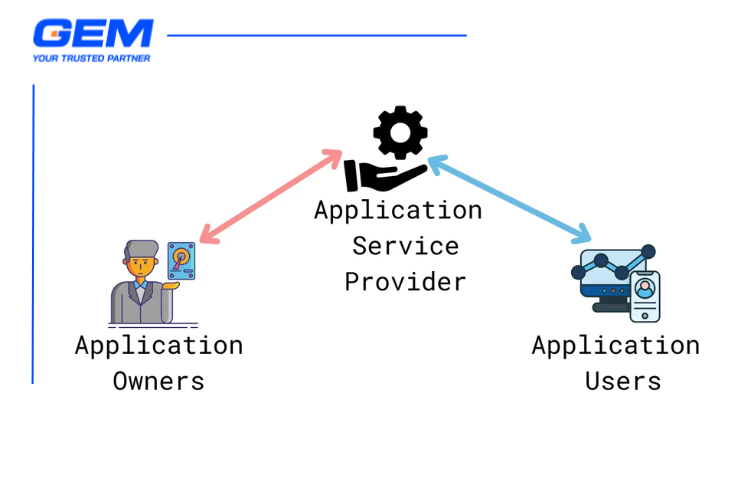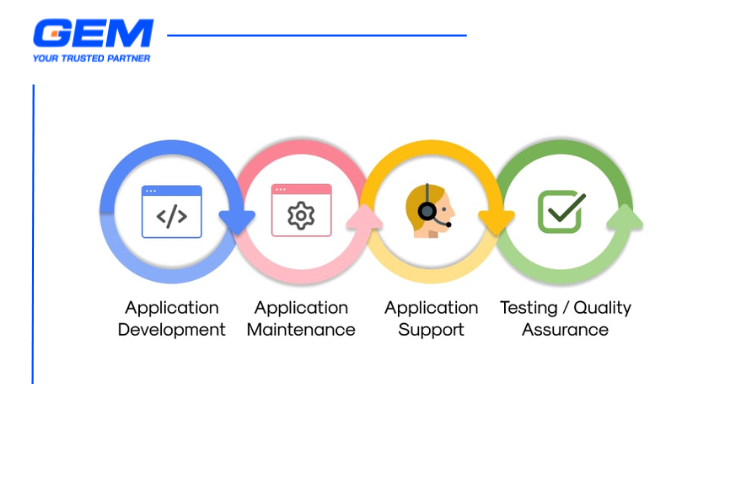Contents
The concept of application service providers (ASPs) gained traction in the late 1990s as companies looked for ways to manage software delivery without expanding internal IT infrastructure. An application service provider delivers software applications over a network, typically through a subscription model. While the popularity of ASPs has shifted with the rise of SaaS, the model remains relevant in specific operational contexts. This article examines what is application service providers, how they function, the types of services they offer, and the business drivers behind their adoption. We also explore where ASPs stand in today’s enterprise technology landscape.
What is Application Service Providers: A Closer Look at the Model
To understand the relevance of application service providers today, it’s important to first examine how the model originated and what it was designed to solve.

What is Application Service Providers?
An application service provider (ASP) is a third-party organization that hosts software applications and delivers them to clients over a network.
Instead of purchasing and maintaining software on-premise, businesses access applications remotely, often through a subscription or usage-based model. The software is typically managed in a centralized environment, with clients using a web interface or a thin client to interact with it.
The Historical Context Behind ASPs
The ASP model gained visibility in the late 1990s. During this period, organizations faced growing pressure to manage increasingly complex software environments across distributed locations. Many mid-sized companies lacked the infrastructure and personnel needed to support these systems internally.
At the same time, the cost of licensing, deployment, and maintenance continued to rise. Businesses were looking for ways to streamline operations without expanding their IT footprint. ASPs entered the market offering centralized software delivery, shifting the burden of infrastructure and technical upkeep to an external provider.
Why the ASP Model Emerged
ASPs addressed several operational gaps. Centralized hosting meant that software updates, patches, and security measures could be applied uniformly across all users. This reduced version control issues and minimized downtime. For companies, it also meant fewer upfront costs related to hardware and installation.
While early ASPs offered limited customization and focused on standard business applications, the model represented a shift in how software was consumed. It introduced the idea that access could be prioritized over ownership – a concept that would later define broader trends in cloud-based software delivery.
Explore: https://gem-corp.tech/software-development/software-development-strategies/
How the ASP Mode Works and What Sets It Apart
The ASP model is built on centralized control, remote access, and managed delivery, offering a distinct approach from traditional software deployment.

Centralized Software Delivery
At the core of the ASP model is centralized hosting. Instead of running software locally on each user’s device, applications are installed, maintained, and executed on servers operated by the provider. Clients connect to these applications via a network, usually the internet, using a browser or lightweight client interface. All processing happens on the provider’s infrastructure, not the user’s device.
This setup allows for uniform software deployment across all clients. Updates, patches, and security protocols are applied centrally, eliminating the need for individual installations or manual version control. Providers manage the entire software lifecycle, from deployment to maintenance.
Access and Billing Mechanisms
Clients typically access ASP-hosted applications through secure login portals. Depending on the service agreement, access can be tailored to individual users, departments, or business units. The delivery model supports remote availability, which makes it suitable for organizations with distributed teams or multiple office locations.
Billing models vary based on usage, number of users, or a flat-rate subscription. Most ASPs offer tiered pricing aligned with service levels or support requirements. This approach provides predictable cost structures and aligns IT spending with actual usage patterns.
How ASP Differs from Traditional Software Deployment
In traditional software environments, organizations purchase licenses, install applications on local machines, and manage ongoing maintenance internally. This requires dedicated IT resources, infrastructure investments, and manual oversight for updates and patches.
The ASP model removes these burdens by shifting responsibility to the service provider. Clients no longer manage installations or infrastructure. Instead, they consume software as a managed service, with access handled remotely and upgrades delivered automatically.
This distinction also impacts scalability. While traditional setups require additional infrastructure to support growth, ASPs can scale capacity on the backend, allowing clients to expand usage without direct investment in hardware or support resources.
Infrastructure and Service-Level Expectations
To deliver on performance, ASPs rely on robust data center infrastructure. This includes redundant systems, network load balancing, and security protocols that support stable and secure operations. Providers are responsible for uptime, data protection, and system resilience.
Service-level agreements (SLAs) define the terms of service, including response times, availability metrics, and support provisions. These agreements form the operational backbone of the ASP-client relationship, providing clarity on expectations and accountability.
The ASP model’s architecture is designed to optimize resource efficiency, streamline access, and deliver consistent service across client environments—all from a centralized platform.
Different Types of ASPs
Application service providers operate across a range of business models, shaped by the industries they serve, the scale of their clients, and the geographic markets they target.

Vertical Specialists
Vertical ASPs focus on delivering software built for specific industries or professional domains. Their offerings are tailored to the workflows, compliance requirements, and user expectations of a particular sector.
For example, a healthcare-focused ASP may provide electronic medical records (EMR) systems that align with HIPAA regulations, while a legal services ASP might offer case management tools customized for litigation workflows. These providers often offer deep domain expertise and pre-configured features that reduce implementation time for industry-specific use cases.
Broad Service Providers
Also known as horizontal ASPs, these providers offer general-purpose applications that are applicable across industries. Typical solutions include email hosting, accounting platforms, human resource management systems, and customer relationship management (CRM) software.
One example is an ASP delivering cloud-based payroll services to clients in retail, finance, and logistics. The broad applicability of these tools makes them attractive to organizations looking for standardized capabilities without sector-specific customizations.
Enterprise-Focused Providers
Some ASPs are structured to serve mid-sized and large enterprises that require advanced configuration, integration with legacy systems, or compliance with corporate IT standards. These providers often support multi-tenant environments, complex user hierarchies, and role-based access.
For instance, an enterprise ASP might offer a project management platform that integrates with ERP systems and supports enterprise-grade security protocols. Their service agreements frequently include dedicated support teams, onboarding services, and full audit trails.
Region-Specific Providers
Region-specific ASPs tailor their services to meet local regulations, language requirements, or market dynamics. These providers typically operate in countries or regions where data sovereignty, user behavior, or regulatory frameworks differ from global norms.
An example would be an ASP based in the Middle East offering invoicing and tax compliance tools aligned with local VAT laws, or a European provider ensuring GDPR-compliant document storage and processing. Their value lies in localized expertise and faster response times for nearby clients.
The Pros and Cons of ASPs
While application service providers offer a managed approach to software delivery, their value depends on business context, operational needs, and long-term IT strategy. We’ve prepared a list of the primary advantages and limitations associated with the ASP model.

Advantages of ASPs
- Centralized software management
Updates, patches, and security measures are handled by the provider, reducing internal IT workload across locations.
- Lower upfront investment
Businesses access enterprise-grade software without the capital expenditure typically required for licenses, servers, or installation.
- Flexible cost structure
Subscription or usage-based pricing aligns IT spending with actual consumption, supporting more accurate budgeting.
- Scalability on demand
ASPs can adjust capacity to accommodate growth, seasonal demand, or new business units without infrastructure redesign.
- Remote accessibility
Applications are accessible across geographies, which supports distributed teams and mobile workforces.
Limitations of ASPs
- Vendor dependency
Transitioning away from an ASP can involve data migration challenges, format incompatibility, and complex exit terms.
- Limited customization
Standardized platforms may not support specialized workflows or integrate easily with legacy systems.
- Data control concerns
Clients must rely on third-party infrastructure for storage and security, raising questions around compliance, access, and risk management.
- Variable service quality
The reliability of service-level agreements (SLAs) can vary, and not all providers offer the same level of transparency or accountability.
- Strategic Considerations
Organizations evaluating ASPs need to assess not only technical capabilities but also the provider’s ability to meet compliance requirements, integrate with legacy systems, and support long-term flexibility. The model delivers operational efficiencies, but it introduces trade-offs that should be examined from both IT and business continuity perspectives.
ASP vs. SaaS: Differences between the 2 Models

The transition from ASP to SaaS reflects broader changes in how software is architected, deployed, and consumed. While both models deliver applications over a network, the underlying infrastructure, scalability, and integration capabilities differ in critical ways that continue to influence enterprise IT decisions.
From ASP to SaaS: A Shift Driven by Infrastructure and User Expectations
Application service providers were among the first to offer remote access to business applications, often hosting single instances of software for each client. This model introduced convenience and cost flexibility, but it was limited by the underlying architecture. Most ASPs operated on a client-specific deployment model, which made upgrades, maintenance, and scaling resource-intensive.
SaaS emerged in the early 2000s as cloud computing matured. SaaS providers developed multi-tenant architectures, allowing multiple customers to use a single instance of the application while keeping data isolated. This shift brought greater efficiency, reduced operational overhead, and faster iteration cycles—making SaaS applications more agile and cost-effective at scale.
Key Architectural and Operational Differences
To identify the differences, we placed both models side by side in this table, focusing on aspects such as architecture, scalability, maintenance, customization, integration, and other operational dimensions.
| Aspect | ASP | SaaS |
| Hosting Environment | Typically runs on a dedicated server or infrastructure per client. Physical or virtual instances are often isolated. | Hosted in a shared, multi-tenant cloud environment with logical data separation across customers. |
| Architecture | Single-tenant setups: each client has a separate software instance. Often inflexible and harder to scale. | Built on multi-tenant, cloud-native architecture. Optimized for centralized updates and resource sharing. |
| Technology Base | Frequently based on legacy software retrofitted for online access. Not always optimized for browser use or mobile responsiveness. | Developed as cloud-first applications using modern frameworks and APIs. Designed for web and mobile environments. |
| Scalability | Limited scalability due to individualized infrastructure. Scaling often requires manual provisioning and hardware upgrades. | Highly scalable through elastic cloud infrastructure. Resources adjust dynamically based on demand. |
| Maintenance | Maintenance is handled per client, often requiring downtime and coordination for upgrades or fixes. | Updates are rolled out centrally with minimal or no disruption to users. Maintenance is nearly invisible to the client. |
| Customization | High customization options, but often expensive and time-consuming. Custom features may complicate upgrades. | Limited to predefined configurations. Deep customization is rare but supported through APIs or extensions. |
| Integration | Integration with other systems may require custom connectors or middleware. Legacy protocols are common. | API-driven integration with modern platforms. Often includes native connectors for CRMs, ERPs, and productivity tools. |
| Security | Security policies and controls are managed individually per client. Varying levels of maturity and enforcement. | Centralized security policies, often certified against industry standards (e.g., ISO 27001, SOC 2). Continuous monitoring and patching. |
| Cost Model | Typically higher due to dedicated infrastructure, custom maintenance, and individualized support. | More cost-efficient due to shared infrastructure, centralized updates, and standardized service delivery. |
| Deployment Speed | Slower deployment cycles due to client-specific setup and testing. | Faster deployment with standardized onboarding and provisioning. |
| User Experience | May vary across clients based on version, configuration, and infrastructure quality. | Consistent experience across users, with responsive design and regular UX improvements. |
This breakdown reflects not only the technical contrasts between ASP and SaaS but also how those differences affect business decisions, particularly in relation to cost control, time-to-deploy, and long-term maintainability. While ASPs may still be suited for niche or regulated use cases, SaaS has become the prevailing model for organizations prioritizing speed, scale, and compatibility with modern IT ecosystems.
Explore more: Top 15 Software Outsourcing Company In Vietnam (Updated 2025)
Where ASPs Fit Today: Real-World Use Cases and Sector Adoption

While SaaS has become the dominant model for cloud-based software delivery, ASPs continue to serve specific business needs—particularly in sectors where customization, regulatory alignment, or localized support are non-negotiable.
- Healthcare Compliance Portals
Hospitals and clinics working under strict privacy regulations often rely on ASPs to host electronic medical records (EMR) systems. These solutions are configured to meet HIPAA or GDPR requirements, with data stored on dedicated infrastructure. ASP-hosted platforms also support integration with lab systems, imaging, and billing.
- Legal Case Management
Law firms frequently turn to ASPs for case tracking, document storage, and billing systems that align with jurisdiction-specific protocols. These platforms often offer custom workflows and audit trails required for legal compliance, which off-the-shelf SaaS tools typically don’t provide.
- Financial Services Platforms
In banking, wealth management, and insurance, ASPs are used to host risk assessment tools, loan origination systems, and investment portfolio platforms. Their infrastructure supports encryption standards and data residency requirements, often dictated by local regulators.
- Public Sector and Government Agencies
Government departments, especially at the municipal or regional level, use ASPs for services like permit applications, records management, and procurement platforms. These systems are customized for local processes and hosted on infrastructure governed by national security regulations.
- Industrial and Manufacturing ERPs
Mid-sized manufacturers often adopt ASP-hosted ERP systems tailored to their production workflows, logistics, and supplier networks. These platforms integrate with legacy systems on the shop floor and support features like batch tracking, MRP, and vendor compliance auditing.
GEM works with organizations in healthcare, legal, and public service to deliver ASP solutions that reflect the operational demands of each domain. Our approach combines custom-built applications, secure infrastructure, and integration with existing systems, giving teams the tools to manage sensitive processes without compromising on performance or oversight. With services ranging from cloud-native development to security testing and data governance, GEM helps clients structure hosted environments that meet regulatory mandates and support long-term continuity. This model suits institutions that require precision, accountability, and control across every layer of their digital operations.
Key Takeaways
So you know what is application service providers? Application service providers (ASPs) offer a hosted software delivery model that supports remote access, centralized maintenance, and tailored deployment. Unlike SaaS, ASPs often operate on dedicated infrastructure, allowing for higher customization and regulatory alignment. While SaaS dominates in scale-driven environments, ASPs remain relevant in sectors like healthcare, legal, and public services, where control and compliance shape IT priorities. Understanding what is an application service providers helps clarify where legacy models still hold value and why some organizations continue to prioritize them in specialized, high-stakes operational contexts.
Looking to implement a hosted solution tailored to your industry’s demands? Contact GEM to explore how our ASP delivery model can support your infrastructure, compliance, and operational goals.





